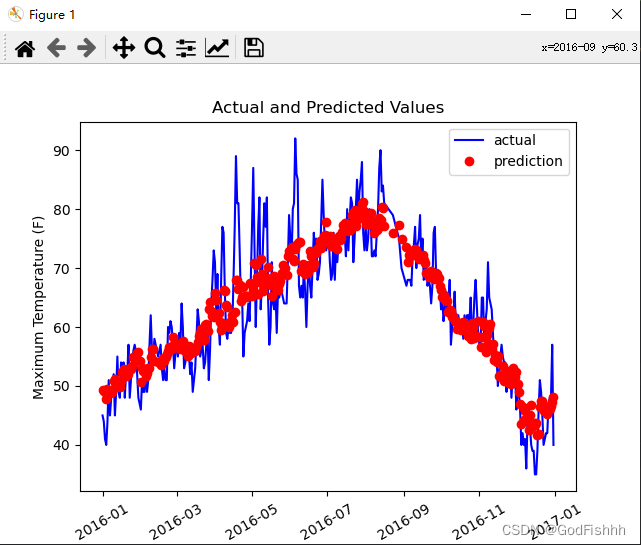深度学习(13)--PyTorch搭建神经网络进行气温预测
一.搭建神经网络进行气温预测流程详解
1.1.导入所需的工具包
import numpy as np # 矩阵计算
import pandas as pd # 数据读取
import matplotlib.pyplot as plt # 画图处理
import torch # 构建神经网络
import torch.optim as optim # 设置优化器1.2.读取并处理数据
引入数据并查看数据的格式
# 引入数据
features = pd.read_csv('temps.csv')
# 看看数据长什么样子
print(features.head())
Pandas库中的.head()函数,取数据的前n行数据,默认是取前五行数据,如上图所示。
查看数据维度
print('数据维度:', features.shape)
shape函数的功能是读取矩阵的长度,.shape直接输出数据的维度,如上图,表示该数据的维度为348行,9列。对应的也就是348个样本,9个特征。
而shape[0],shape[1]则分别返回矩阵第一维度、第二维度的长度:
# 查看数据维度
print('数据维度:', features.shape[0])
print('数据维度:', features.shape[1])处理时间数据
# 处理时间数据
import datetime
# 分别得到年,月,日
years = features['year']
months = features['month']
days = features['day']
# datetime格式
dates = [str(int(year)) + '-' + str(int(month)) + '-' + str(int(day)) for year, month, day in zip(years, months, days)]
dates = [datetime.datetime.strptime(date, '%Y-%m-%d') for date in dates]查看处理的datas数据格式
print(dates[:3])
对特殊数据进行one-hot编码
计算机无法识别字符串数据,所以对于字符串数据需要使用one-hot编码:
features = pd.get_dummies(features) # get_dummies会自动判断数据中哪一列是字符串,并自动将字符串展开。
# eg:数据中用于标注星期的字符串一共有七个,则get_dummies函数将数据展开成七列,当天是哪一天就在相应位置标1。
# 星期 一 二 三 四 五 六 七,如果是星期一则标注为:1 0 0 0 0 0 0,如果是星期三则标注为:0 0 1 0 0 0 0,如果是星期六则标注为:0 0 0 0 0 1 0
查看one-hot编码后的数据

对标签进行处理
# 标签
labels = np.array(features['actual']) # 获取标签:features获取actual的标签然后再转换为np.array的格式
# 在特征中去掉标签
features= features.drop('actual', axis = 1) # 去除features中的actual标签,axis表示沿着行/列去除,axis=0按行计算,axis=1按列计算
# 名字单独保存一下,以备后患
feature_list = list(features.columns) # 保存features中的columns值,也就是列
# 转换成合适的格式
features = np.array(features) # 把处理后的features数据也转换为np.array格式标准化处理
不同的数据取值范围不同,而机器又会认为数值大的数据较为重要,所以需要对数据进行标准化(x-μ/σ) -- μ为均值,σ为标准差。
from sklearn import preprocessing
input_features = preprocessing.StandardScaler().fit_transform(features) # fit_transform通过数据计算出均值和标准差,再对数据进行标准化处理变换。fit_transform通过数据计算出均值和标准差,再对数据进行标准化处理变换。
标准化处理前后的数据:

1.3.构建网络模型
构建网络
本项目构建的网络模型较为简单,只有一个隐层
# shape[0]是样本数,也就是行的数据,shape[1]是特征数,也就是列的数据
input_size = input_features.shape[1]
hidden_size = 128
output_size = 1
batch_size = 16 # 一次迭代batch个样本
my_nn = torch.nn.Sequential(
torch.nn.Linear(input_size, hidden_size), # 根据输入自动初始化权重参数和偏重值
torch.nn.ReLU(), # 激活函数 Sigmoid/Relu
torch.nn.Linear(hidden_size, output_size),
)
cost = torch.nn.MSELoss(reduction='mean') # 损失函数设置:MSE均方误差
optimizer = torch.optim.Adam(my_nn.parameters(), lr=0.001)
# 优化器设置:Adam,参数为网络中的所有参数以及学习率训练网络
# 训练网络
losses = []
# 迭代1000次,epoch = 1000
for i in range(1000):
batch_loss = []
# MINI-Batch方法来进行训练
for start in range(0, len(input_features), batch_size): # 循环范围为0~样本数,每次循环中间间隔batchs_size
end = start + batch_size if start + batch_size < len(input_features) else len(input_features) # 做一个索引是否越界的判断
# 取得一个batch的数据
xx = torch.tensor(input_features[start:end], dtype = torch.float, requires_grad = True)
yy = torch.tensor(labels[start:end], dtype = torch.float, requires_grad = True)
prediction = my_nn(xx) # 输入值经过定义的网络运算得到预测值
loss = cost(prediction, yy) # 参数为预测值和真实值
optimizer.zero_grad() # torch的迭代过程中会累计之前的训练结果,所以在每次迭代中需要清空梯度值
loss.backward(retain_graph=True) # 反向传播
optimizer.step() # 对所有参数进行更新
batch_loss.append(loss.data.numpy())
# 打印损失
if i % 100==0:
losses.append(np.mean(batch_loss))
print(i, np.mean(batch_loss))预测训练结果
x = torch.tensor(input_features, dtype = torch.float)
# 先将数据转换为tensor格式,因为需要在网络中进行运算
predict = my_nn(x).data.numpy()
# 在网络中运算完成中,再转换为data.numpy格式,因为后续需要进行画图处理1.4.对结果进行画图对比
# 转换日期格式
dates = [str(int(year)) + '-' + str(int(month)) + '-' + str(int(day)) for year, month, day in zip(years, months, days)]
dates = [datetime.datetime.strptime(date, '%Y-%m-%d') for date in dates]
# 创建一个表格来存日期和其对应的标签数值
true_data = pd.DataFrame(data={'date': dates, 'actual': labels})
# 同理,再创建一个来存日期和其对应的模型预测值
months = features[:, feature_list.index('month')]
days = features[:, feature_list.index('day')]
years = features[:, feature_list.index('year')]
test_dates = [str(int(year)) + '-' + str(int(month)) + '-' + str(int(day)) for year, month, day in zip(years, months, days)]
test_dates = [datetime.datetime.strptime(date, '%Y-%m-%d') for date in test_dates]
predictions_data = pd.DataFrame(data = {'date': test_dates, 'prediction': predict.reshape(-1)}) # predict是x经过网络训练再转换为np.array的值
# 画图
# 真实值
plt.plot(true_data['date'], true_data['actual'], 'b-', label='actual') # 参数分别为:横轴,纵轴,曲线颜色,标签值
# 预测值
plt.plot(predictions_data['date'], predictions_data['prediction'], 'ro', label='prediction') # 参数分别为:横轴,纵轴,曲线颜色,标签值
plt.xticks(rotation=30) # x轴参数倾斜60°
plt.legend() # 使上述代码产生效果
# 图名
plt.xlabel('Date')
plt.ylabel('Maximum Temperature (F)') # x,y轴标签设置
plt.title('Actual and Predicted Values') # 图名设置
# 保存图片并展示
plt.savefig("result.png")
plt.show()二.完整代码
import numpy as np # 矩阵计算
import pandas as pd # 数据读取
import matplotlib.pyplot as plt # 画图处理
import torch # 构建神经网络
import torch.optim as optim # 设置优化器
# 处理时间数据
import datetime
from sklearn import preprocessing
# 引入数据
features = pd.read_csv('temps.csv')
# 看看数据长什么样子
# print(features.head())
# 查看数据维度
# print('数据维度:', features.shape)
# 分别得到年,月,日
years = features['year']
months = features['month']
days = features['day']
'''
# datetime格式
dates = [str(int(year)) + '-' + str(int(month)) + '-' + str(int(day)) for year, month, day in zip(years, months, days)]
dates = [datetime.datetime.strptime(date, '%Y-%m-%d') for date in dates]
print(dates[:3])
'''
# 独热(one-hot)编码 -- 机器不认识字符串,需要将字符串转换为机器认识的参数
features = pd.get_dummies(features)
# get_dummies会自动判断数据中哪一列是字符串,并自动将字符串展开
# eg:数据中用于标注星期的字符串一共有七个,则get_dummies函数将数据展开成七列,当天是哪一天就在相应位置标1
# 星期 一 二 三 四 五 六 七,如果是星期一则标注为:1 0 0 0 0 0 0,如果是星期三则标注为:0 0 1 0 0 0 0,如果是星期六则标注为:0 0 0 0 0 1 0
# print(features.head(5))
# 标签
labels = np.array(features['actual']) # 获取标签:features获取actual的标签然后再转换为np.array的格式
# 在特征中去掉标签
features = features.drop('actual', axis = 1) # 去除features中的actual标签,axis表示沿着行/列去除,axis=0按行计算,axis=1按列计算
# 名字单独保存一下,以备后患
feature_list = list(features.columns) # 保存features中的columns值,也就是列
# 转换成合适的格式
features = np.array(features) # 把处理后的features数据也转换为np.array格式
# print(features[0])
# 标准化处理
input_features = preprocessing.StandardScaler().fit_transform(features)
# fit_transform通过数据计算出均值和标准差,再对数据进行标准化处理变换。
# print(input_features[0])
# shape[0]是样本数,也就是行的数据,shape[1]是特征数,也就是列的数据
input_size = input_features.shape[1]
hidden_size = 128
output_size = 1
batch_size = 16 # 一次迭代batch个样本
my_nn = torch.nn.Sequential(
torch.nn.Linear(input_size, hidden_size), # 根据输入自动初始化权重参数和偏重值
torch.nn.ReLU(), # 激活函数 Sigmoid/ReLU
torch.nn.Linear(hidden_size, output_size),
)
cost = torch.nn.MSELoss(reduction='mean') # 损失函数设置:MSE均方误差
optimizer = torch.optim.Adam(my_nn.parameters(), lr=0.001)
# 优化器设置:Adam,参数为网络中的所有参数以及学习率
# 训练网络
losses = []
# 迭代1000次,epoch = 1000
for i in range(1000):
batch_loss = []
# MINI-Batch方法来进行训练
for start in range(0, len(input_features), batch_size): # 循环范围为0~样本数,每次循环中间间隔batchs_size
end = start + batch_size if start + batch_size < len(input_features) else len(input_features) # 做一个索引是否越界的判断
# 取得一个batch的数据
xx = torch.tensor(input_features[start:end], dtype=torch.float, requires_grad=True)
yy = torch.tensor(labels[start:end], dtype=torch.float, requires_grad=True)
prediction = my_nn(xx) # 输入值经过定义的网络运算得到预测值
loss = cost(prediction, yy) # 参数为预测值和真实值
optimizer.zero_grad() # torch的迭代过程中会累计之前的训练结果,所以在每次迭代中需要清空梯度值
loss.backward(retain_graph=True) # 反向传播
optimizer.step() # 对所有参数进行更新
batch_loss.append(loss.data.numpy())
'''
# 打印损失
if i % 100 == 0:
losses.append(np.mean(batch_loss))
print(i, np.mean(batch_loss))
'''
# 预测训练结果
x = torch.tensor(input_features, dtype=torch.float)
# 先将数据转换为tensor格式,因为需要在网络中进行运算
predict = my_nn(x).data.numpy()
# 在网络中运算完成中,再转换为data.numpy格式,因为后续需要进行画图处理
# 转换日期格式
dates = [str(int(year)) + '-' + str(int(month)) + '-' + str(int(day)) for year, month, day in zip(years, months, days)]
dates = [datetime.datetime.strptime(date, '%Y-%m-%d') for date in dates]
# 创建一个表格来存日期和其对应的标签数值
true_data = pd.DataFrame(data={'date': dates, 'actual': labels})
# 同理,再创建一个来存日期和其对应的模型预测值
months = features[:, feature_list.index('month')]
days = features[:, feature_list.index('day')]
years = features[:, feature_list.index('year')]
test_dates = [str(int(year)) + '-' + str(int(month)) + '-' + str(int(day)) for year, month, day in zip(years, months, days)]
test_dates = [datetime.datetime.strptime(date, '%Y-%m-%d') for date in test_dates]
predictions_data = pd.DataFrame(data = {'date': test_dates, 'prediction': predict.reshape(-1)}) # predict是x经过网络训练再转换为np.array的值
# 画图
# 真实值
plt.plot(true_data['date'], true_data['actual'], 'b-', label='actual') # 参数分别为:横轴,纵轴,曲线颜色,标签值
# 预测值
plt.plot(predictions_data['date'], predictions_data['prediction'], 'ro', label='prediction') # 参数分别为:横轴,纵轴,曲线颜色,标签值
plt.xticks(rotation=30) # x轴参数倾斜60°
plt.legend() # 使上述代码产生效果
# 图名
plt.xlabel('Date')
plt.ylabel('Maximum Temperature (F)') # x,y轴标签设置
plt.title('Actual and Predicted Values') # 图名设置
# 保存图片并展示
plt.savefig("result.png")
plt.show()
三.输出结果


